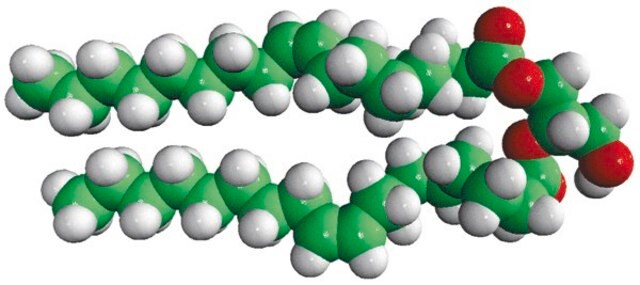L7895
Lipopolysaccharides from Salmonella typhosa
γ-irradiated, BioXtra, suitable for cell culture
Sinonimo/i:
LPS
Autenticatiper visualizzare i prezzi riservati alla tua organizzazione & contrattuali
About This Item
Prodotti consigliati
Origine biologica
bacterial (Salmonella typhosa)
Livello qualitativo
Sterilità
γ-irradiated
Nome Commerciale
BioXtra
Stato
lyophilized powder
Purificato mediante
gel-filtration chromatography
tecniche
cell culture | mammalian: suitable
Impurezze
<1% Protein (Lowry)
Colore
white to faint yellow
Solubilità
water: 0.90-1.10 mg/mL, faintly hazy to hazy, colorless to faintly yellow
Temperatura di conservazione
2-8°C
Cerchi prodotti simili? Visita Guida al confronto tra prodotti
Applicazioni
Lipopolysaccharides (LPSs) are characteristic components of the cell wall of Gram-negative bacteria. LPS and its lipid A moiety stimulate cells of the innate immune system by the Toll-like receptor 4 (TLR4), a member of the Toll-like receptor protein family, which recognizes common pathogen-associated molecular-patterns (PAMPs).
Lipopolysaccharides from Salmonella typhosa are used in cell culture and cell binding applications. The role of LPS in the secretion of TNF-α and IL-6 was studied in mouse spleen cell culture. It was used to study the role of inflammatory responses in multiple sclerosis.
Azioni biochim/fisiol
Lipopolysaccharides (LPSs) are characteristic components of the cell wall of Gram-negative bacteria. LPS and its lipid A moiety stimulate cells of the innate immune system by the Toll-like receptor 4 (TLR4), a member of the Toll-like receptor protein family, which recognizes common pathogen-associated molecular-patterns (PAMPs).
Altre note
To gain a comprehensive understanding of our extensive range of Lipopolysaccharides for your research, we encourage you to visit our Carbohydrates Category page.
Prodotti correlati
N° Catalogo
Descrizione
Determinazione del prezzo
Codice della classe di stoccaggio
11 - Combustible Solids
Classe di pericolosità dell'acqua (WGK)
WGK 3
Punto d’infiammabilità (°F)
Not applicable
Punto d’infiammabilità (°C)
Not applicable
Dispositivi di protezione individuale
Eyeshields, Gloves, type N95 (US)
Scegli una delle versioni più recenti:
Possiedi già questo prodotto?
I documenti relativi ai prodotti acquistati recentemente sono disponibili nell’Archivio dei documenti.
I clienti hanno visto anche
D N Dao et al.
Infection and immunity, 72(4), 2067-2074 (2004-03-25)
The mycobacterial cell wall component lipoarabinomannan (LAM) has been described as a virulence factor of Mycobacterium tuberculosis, and modification of the terminal arabinan residues of this compound with mannose caps (producing mannosyl-capped LAM [ManLAM]) in M. tuberculosis or with phosphoinositol
Aurélien Godinat et al.
Current protocols in chemical biology, 6(3), 169-189 (2014-09-11)
The great complexity of many human pathologies, such as cancer, diabetes, and neurodegenerative diseases, requires new tools for studies of biological processes on the whole organism level. The discovery of novel biocompatible reactions has tremendously advanced our understanding of basic
Johnathan Ho et al.
PLoS biology, 14(10), e2000117-e2000117 (2016-10-26)
STAT2 is the quintessential transcription factor for type 1 interferons (IFNs), where it functions as a heterodimer with STAT1. However, the human and murine STAT2-deficient phenotypes suggest important additional and currently unidentified type 1 IFN-independent activities. Here, we show that
Yasuhisa Ano et al.
Nutrients, 11(9) (2019-09-12)
The number of patients with mental illnesses is rapidly increasing, and daily lifestyle is closely associated with the development of symptoms. It is suggested that inflammatory molecules derived from microglia play crucial roles for the pathophysiology of depression. In the
Armin Neininger et al.
The Journal of biological chemistry, 277(5), 3065-3068 (2001-12-14)
We demonstrate that lipopolysaccharide-induced tumor necrosis factor (TNF) biosynthesis becomes independent of MAPKAP kinase 2 (MK2) when the AU-rich element (ARE) of the TNF gene is deleted. In spleen cells and macrophages where TNF biosynthesis is restored as a result
Il team dei nostri ricercatori vanta grande esperienza in tutte le aree della ricerca quali Life Science, scienza dei materiali, sintesi chimica, cromatografia, discipline analitiche, ecc..
Contatta l'Assistenza Tecnica.


